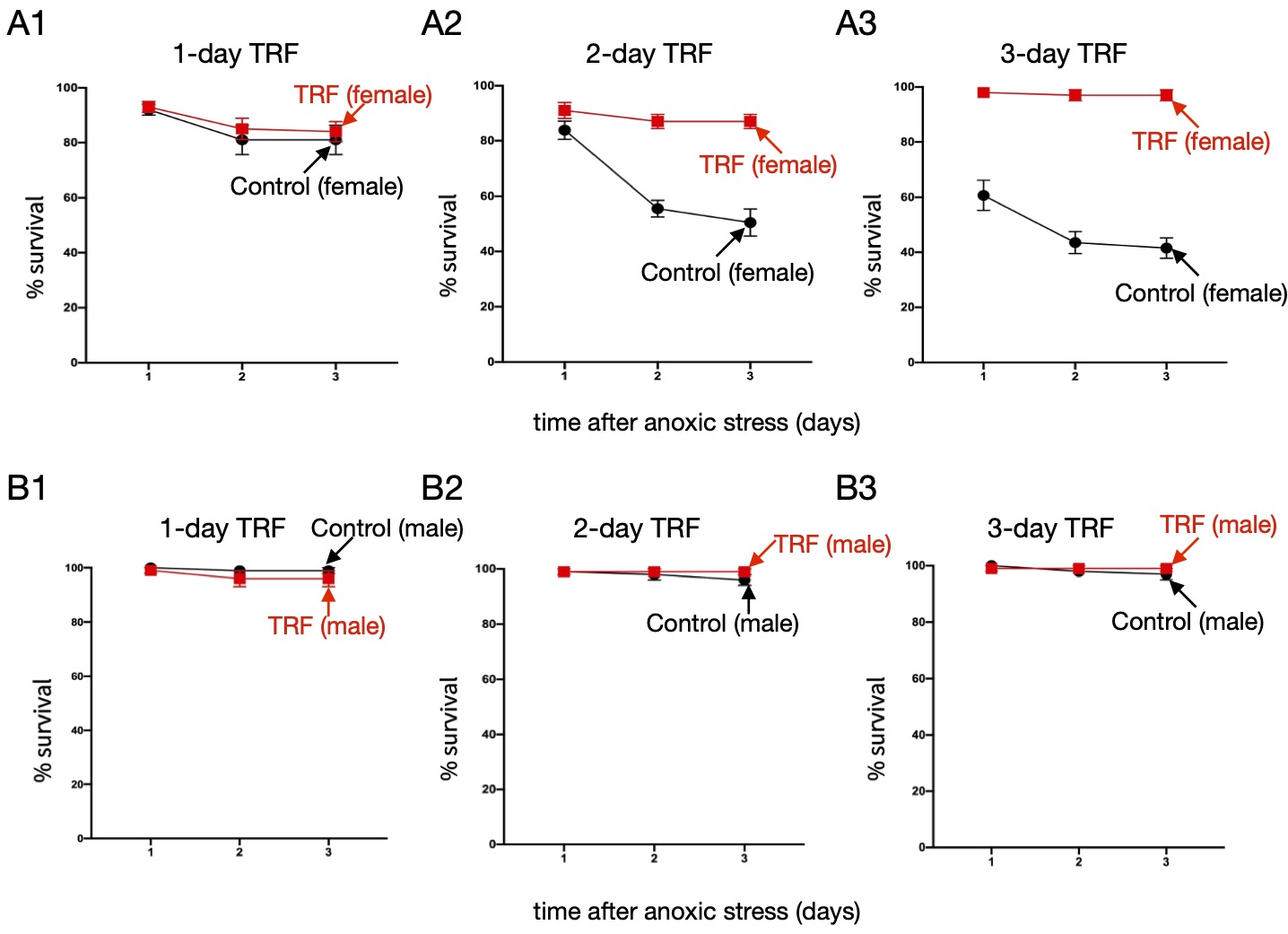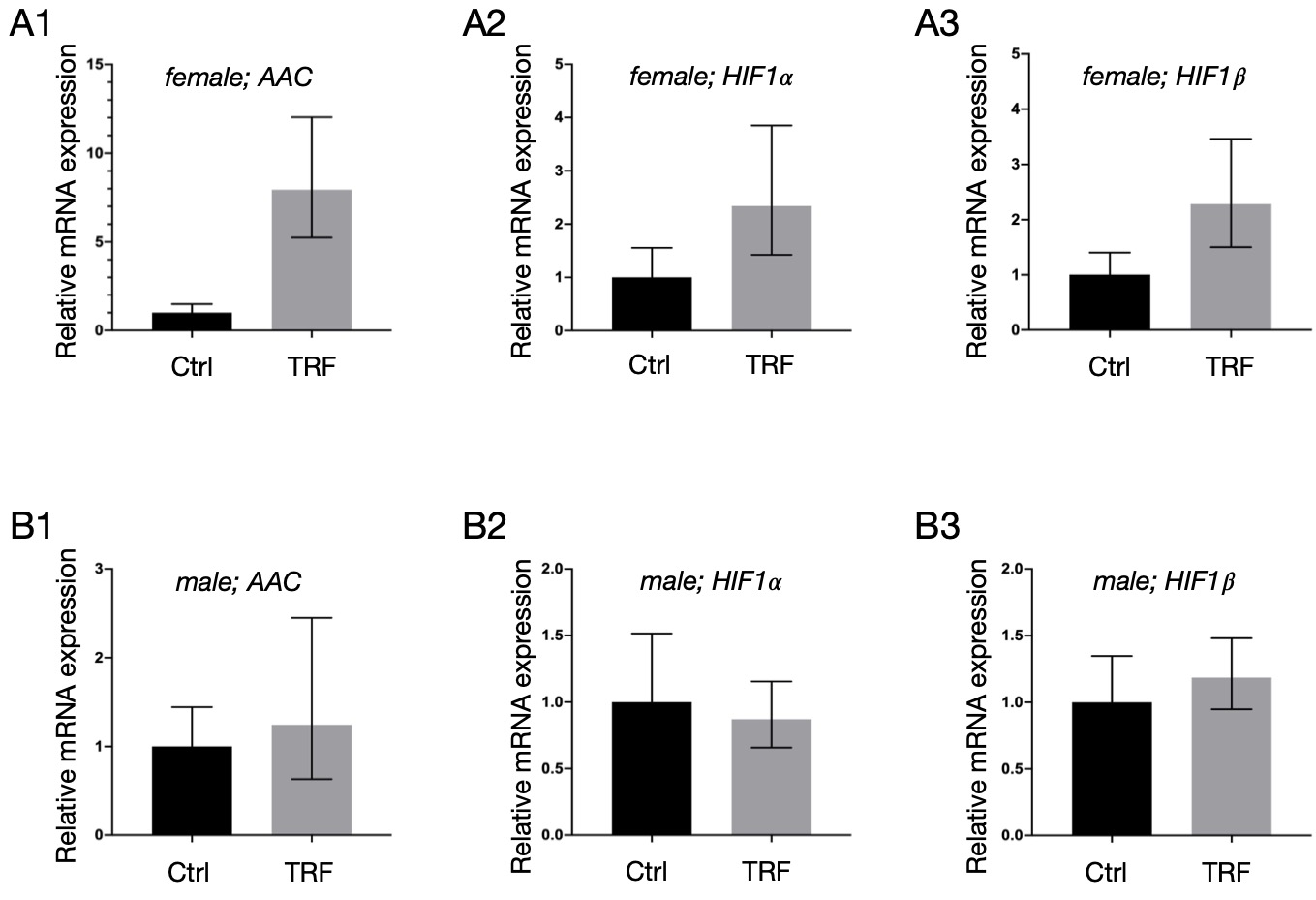Back
Purpose: Time-restricted feeding (TRF) has demonstrated numerous health benefits. Therefore, it was investigated if TRF has the potential to protect organisms from anoxic stress using a Drosophila as an in vivo model system.
Methods: Newly eclosed w1118 flies were subjected to 1, 2, and 3 days of an 8-hour fed: 16-hour fasted TRF regimen. After that, the flies were exposed to anoxic stress (100 % N2) for 2 hours. Survival rates were monitored for the following 3 days. In addition, qPCR with genes involved in fat metabolisms and oxygen sensing were measured to uncover molecular mechanisms underlying TRF-induced cellular changes.
Results: Practicing the TRF for 1 day did not reveal any significant protective effects against the anoxic stress when measuring the survival rate on the 3rd day after the assault (TRF female survival rate, 84.0±3.7%, control female survival rate, 81.0±5.3%, TRF male survival rate 96.0±2.9%, control male survival rate 99.0±1.1%). However, its protective effects were noticeable when extending the duration of TRF. When practicing TRF for 2 days, 87.0±2.6% of female flies on TRF survived while only 50.5±4.9% of control female flies were viable. The difference became more considerable when practicing TRF for 3 days (TRF female survival rate, 97.0±2.0%, control female survival rate, 41.5±3.7%). In stark contrast, no protective effects of TRF were observed with male flies even in the 3-day TRF regimen (TRF male survival rate 99.0±1.0%, control male survival rate 97.0±2.0%). To unravel molecular mechanisms underlying these results, the levels of acetyl-CoA carboxylase (ACC), a pivotal enzyme to catalyze fatty acid synthesis, hypoxia-inducible factor1 𝛼 (HIF1𝛼), and HIF1𝛽 were measured. Consistent with the survival assay, it was found a strong trend in an increase of the expression of each gene in female flies upon TRF (7.9, 2.3, and 2.3 fold increase for ACC, HIF1𝛼, and HIF1𝛽, respectively) while their expression levels remained essentially unchanged in male flies.
Conclusion: TRF may exert its beneficial effects on alleviating tissue damage against anoxic stress by up-regulating the expression of genes associated with fat metabolisms and oxygen sensing in female flies.
Acknowledgments: This work was supported by the Basic Science Research Program through the National Research Foundation of Korea (NRF) funded by the Ministry of Science, and ICR (NRF-2022R1F1A1074064) to M.K. The authors declare no potential conflict of interest.

Figure1. Effects of TRF (time-restricted feeding) on the survival of flies assaulted by anoxic stress

Figure 2. Effects of TRF (time-restricted feeding) on the expression of genes involved in fat metabolism and oxygen sensing
Discovery and Basic Research - Biology
Category: Late Breaking Poster Abstract
(M1530-10-55) Time-Restricted Feeding Protects Fruit Flies from Anoxic Stress via Up-Regulating Expression of Genes Involved in Fat Metabolism and Oxygen Sensing
Monday, October 17, 2022
3:30 PM – 4:30 PM ET
- NK
Nayoon Kim, Pharm.D.
Inje University
Gimhae, Kyongsang-namdo, Republic of Korea - MK
Man Su Kim, PhD
Professor
Inje University
Gimhae, Kyongsang-namdo, Republic of Korea
Main Author(s)
Presenting Author(s)
Purpose: Time-restricted feeding (TRF) has demonstrated numerous health benefits. Therefore, it was investigated if TRF has the potential to protect organisms from anoxic stress using a Drosophila as an in vivo model system.
Methods: Newly eclosed w1118 flies were subjected to 1, 2, and 3 days of an 8-hour fed: 16-hour fasted TRF regimen. After that, the flies were exposed to anoxic stress (100 % N2) for 2 hours. Survival rates were monitored for the following 3 days. In addition, qPCR with genes involved in fat metabolisms and oxygen sensing were measured to uncover molecular mechanisms underlying TRF-induced cellular changes.
Results: Practicing the TRF for 1 day did not reveal any significant protective effects against the anoxic stress when measuring the survival rate on the 3rd day after the assault (TRF female survival rate, 84.0±3.7%, control female survival rate, 81.0±5.3%, TRF male survival rate 96.0±2.9%, control male survival rate 99.0±1.1%). However, its protective effects were noticeable when extending the duration of TRF. When practicing TRF for 2 days, 87.0±2.6% of female flies on TRF survived while only 50.5±4.9% of control female flies were viable. The difference became more considerable when practicing TRF for 3 days (TRF female survival rate, 97.0±2.0%, control female survival rate, 41.5±3.7%). In stark contrast, no protective effects of TRF were observed with male flies even in the 3-day TRF regimen (TRF male survival rate 99.0±1.0%, control male survival rate 97.0±2.0%). To unravel molecular mechanisms underlying these results, the levels of acetyl-CoA carboxylase (ACC), a pivotal enzyme to catalyze fatty acid synthesis, hypoxia-inducible factor1 𝛼 (HIF1𝛼), and HIF1𝛽 were measured. Consistent with the survival assay, it was found a strong trend in an increase of the expression of each gene in female flies upon TRF (7.9, 2.3, and 2.3 fold increase for ACC, HIF1𝛼, and HIF1𝛽, respectively) while their expression levels remained essentially unchanged in male flies.
Conclusion: TRF may exert its beneficial effects on alleviating tissue damage against anoxic stress by up-regulating the expression of genes associated with fat metabolisms and oxygen sensing in female flies.
Acknowledgments: This work was supported by the Basic Science Research Program through the National Research Foundation of Korea (NRF) funded by the Ministry of Science, and ICR (NRF-2022R1F1A1074064) to M.K. The authors declare no potential conflict of interest.

Figure1. Effects of TRF (time-restricted feeding) on the survival of flies assaulted by anoxic stress

Figure 2. Effects of TRF (time-restricted feeding) on the expression of genes involved in fat metabolism and oxygen sensing
